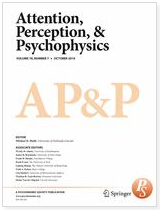上田助教の共著論文が『Attention, Perception, & Psychophysics』に掲載されました
上田祥行助教の共著論文が、米国の学術雑誌『Attention, Perception, & Psychophysics』に掲載されました。情報学研究科・樋口洋子特定研究員らとの共同研究による論文です。
京都大学のウェブサイト内「研究成果」のページには、詳しい論文の概要が日本語で紹介されています。リンク先をご参照ください。
■研究成果|京都大学ウェブサイト
「ヒトは無意識に何を選び学ぶのか -課題に左右される膨大な視覚情報からの取捨選択-」
http://www.kyoto-u.ac.jp/ja/research/research_results/2016/160826_1.html
 Task-relevant information is prioritized in spatiotemporal contextual cueing
Task-relevant information is prioritized in spatiotemporal contextual cueingYoko Higuchi & Yoshiyuki Ueda & Hirokazu Ogawa & Jun Saiki
Attention, Perception, & Psychophysics
○Abstract
Implicit learning of visual contexts facilitates search performance-a phenomenon known as contextual cueing; however, little is known about contextual cueing under situations in which multidimensional regularities exist simultaneously. In everyday vision, different information, such as object identity and location, appears simultaneously and interacts with each other. We tested the hypothesis that, in contextual cueing, when multiple regularities are present, the regularities that are most relevant to our behavioral goals would be prioritized. Previous studies of contextual cueing have commonly used the visual search paradigm. However, this paradigm is not suitable for directing participants’ attention to a particular regularity. Therefore, we developed a new paradigm, the “spatiotemporal contextual cueing paradigm,” and manipulated task-relevant and task-irrelevant regularities. In four experiments, we demonstrated that task-relevant regularities were more responsible for search facilitation than task-irrelevant regularities. This finding suggests our visual behavior is focused on regularities that are relevant to our current goal.
DOI: http://dx.doi.org/10.3758/s13414-016-1198-0 ※認証有り
2016/09/16